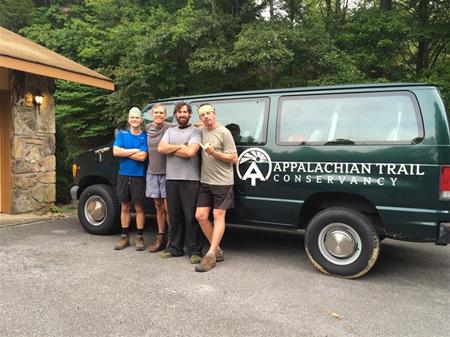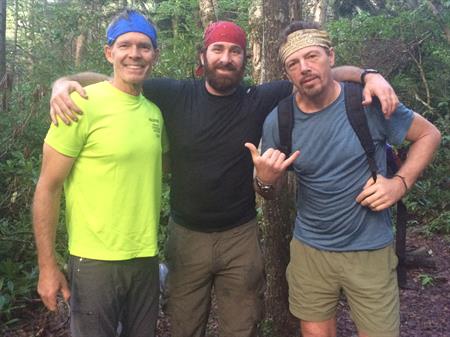by Bryan Alper
Trail Work: My Pilgrimage
July 11, 2017
This blog was adapted from the trail journal Bryan kept in 2015 during his third year working on the Smokies Wilderness Elite Appalachian Trail Crew, appropriately known as S.W.E.A.T.
I am always looking for ways to include more outdoor adventure in my life. I believe it’s important to find what you love and revel in the pleasant distraction of it. For me, that pleasant distraction has been to getting outside and experiencing the thrill of nature on the Appalachian Trail (A.T.).
When I first heard about open registration to work on the S.W.E.A.T. crew in the Great Smoky Mountains, I got excited about the possibility of taking an exceptional backpacking trip. I figured that, instead of doing my usual lone northbound section hike, I would try something new.
I registered through the Appalachian Trail Conservancy (ATC) and got accepted. It felt like I was going back to summer camp. When the first day of crew orientation drew near, I would drive about four hours from Atlanta to just outside of Gatlinburg, Tennessee, where the S.W.E.A.T. Crew’s headquarters is located.
Fast-forward a few years, and I am on my third S.W.E.A.T. crew trip. I am excited to tap back into what I love the most: that feeling of freedom I get being with mother nature on the A.T. in the deep, vast wilderness of the Great Smoky Mountains National Park.
On this trip, I plan to further develop my trail maintenance skills. I am excited about different possibilities, like handling a crosscut saw if we come upon a fallen tree blocking the Trail (commonly known as a “blow down”) or routinely building in A-frames to prevent erosion on the trail, or simply swinging a swing blade to chop off over-brush. With the backdrop of the Smokies, it never really feels like “work.”
August 18
It’s the morning of the first day; the Trail crew volunteers and leaders have congregated and getting ready for orientation. During this session of S.W.E.A.T. — one of eight sessions total — there will be four of us in this session, which is smaller than the average group size, but we will see if we can match a larger group’s level of enthusiasm.

The S.W.E.A.T. Crew poses by the ATC van before heading off into the Smokies.
The S.W.E.A.T. Crew poses by the ATC van before heading off into the Smokies.
After a half-day orientation, completing the Crew Fit test and getting to know fellow crew members, we load up the essential tools and equipment, fill up water jugs, ration food bags and all the general prep to get out into the field the next morning.
These folks that I’m about to head out with on this quest have a variety of backgrounds and experiences. First up is Chuck Behrmann from the Jersey Shore, who is in avocado and macadamia nut farm management. He’s in his mid-forties and is a “Triple Crowner,” which means he has completed the A.T., Pacific Crest Trail, and Continental Divide Trail in their entirety.
Next is Morgan Kelley from Nashville, Tennessee, who is a line chef and author. He is a section hiker in his mid-twenties and will serve as our S.W.E.A.T. crew leader. This is his eighth trail crew session this 2015 season.
Last is Tim McElhannon from Harpers Ferry, West Virginia, a retired naval pilot and former U.S. diplomat. He is in his fifties and has thru-hiked the A.T.
Everyone, including me, is pumped for tomorrow.
August 19
It’s get-to-it-and-do-it time, and we eat a bacon, egg and cheese grits breakfast prepared by Morgan. The crew seems prepared and our morale is solid, ready for anything.
We hop in the ATC van and head out into some of the deepest backcountry areas of the Smokies. Eventually we arrive at the trailhead, unload our gear, put on our packs, and begin our hike into some of the highest peaks in the Appalachians. We will backpack about nine miles in with several thousand feet in elevation change.
We have carried everything we need for our six-day trek into the field, from gear, tools and safety equipment to shelters and sustenance. Our individual pack weight averages at about sixty pounds including hand-carrying tools for fieldwork. We are finally in what seems like the middle of nowhere to set up camp. After nine miles of climbing, I am spent.
Yet despite the exhaustion, I hardly think about it because it’s so much fun trekking into the Smokies — it’s a whole different world that I haven’t seen for quite some time. The crew seems ready to work and we get along well, laughing a lot and getting to know one another.
I daydream just a little bit, imagining what it would have been like if we were in the Conservation Civilian Corps back in the 1930s when the A.T. was first constructed. Conditions must have been much harsher and more demanding in those times, since the Trail did not fully exist yet. Still, many of the tools we use today aren’t much different from those used almost a century ago.
August 20
Today, Chuck and I take a section of the trail ahead from the others and we are given the chore of clipping over-brush — and trust me when I mention that it is a chore. But working with Chuck makes the time pass more quickly. He has a lot of knowledge and experience to share, so I make sure to listen closely to his words.

The entire crew’s favorite time of day: dinnertime.
“The biggest impression I take away from the S.W.E.A.T. Crew is an even greater sense of contribution, organization and teamwork it requires from many dedicated individuals and organizations to sustain the A.T.,” he says. “What motivates me the most is to spend valuable time on the S.W.E.A.T. Crew volunteering with a willingness to give back in some small measure to a community that has given so much to so many of us. Anytime the Trail community benefits and leaves behind a positive legacy for those that come after us, I believe it has a far-reaching ripple effect. The A.T. exists and is sustained by positive ambassadorship.”
His words sit with me. For me, Trail work offers a constructive escape away from the grind of the big city. This is a chance to break life down to its simplest components and exist in a peaceful place without all of the daily creature comforts and usual distractions.
Hours go by as we chat and complete our exhausting work. My shoulders burn from having to hold up loppers all day and my feet are tired. I am looking forward to getting back to our campground and cooking our first hot meal and sharing more about each other’s lives and what motivates us to get out here.
Quitting time eventually comes, and we work our way back to camp and congregate for our first hot meal. While inhaling my dinner, I chat with trail crew leader, Morgan, who talks about the importance of building a community of A.T. maintainers.
“It takes a giant force to upkeep and manage the Appalachian Trail, so it’s up to us to build on the relationships we foster in the backcountry, a group who will then, in turn, share their positive experiences with others,” he said. “I hope on the base level that our efforts in the field will help passing hikers consider what they could be doing for the A.T.”
August 21

Me with Chuck Behrmann and Tim ‘The Diplomat’ McElhannon.
Day three begins, and today I will work with Tim McElhannon, who I nickname “The Diplomat.” It’s pretty cool hanging with a real retired naval pilot and former U.S. diplomat, though it’s also a little intimidating. He responds to most requests by coolly saying, “Roger that,” so I soon feel at ease and we get into a discussion about our work and how his perspective has changed since he began working on a Trail crew.
“As an A.T. thru-hiker, I know how much all hikers appreciate a stretch of smooth, clear trail, so it is particularly rewarding to be able to clear our section and create a smooth trail corridor,” he said. “An additional benefit for me, which is equally important, is that I am able to spend a week with a group of people from varied backgrounds who share a common interest in caring for the Appalachian Trail. Our time together is one of the highlights of my year and I know that I learn to be a better, more patient and understanding person by having such close contact with this special group of people.”
August 22
On our sixth day, the crew and I clean our gear and have one last lunch together followed by a recognition ceremony. Here we regroup, reflect and relive our S.W.E.A.T. experiences before our hike out of the Smokies. We’re exhausted and looking forward to our real beds, but I know I will miss it as soon as I hit pavement. During the past week, I have been reminded what trail maintenance is all about: keeping this one-of-a-kind Trail alive for the next person craving an escape into the American woods.
—–
Reflecting back and writing about my third trail crew season experience, I like to think that any hiker who chooses to jump into trail crew work will have as great of an experience as I have. I encourage folks to plan for this trip and see the impact that trail work will have not only on those who experience a well-maintained trail, but also on those who help maintain it. For me, it’s more than moving rocks, cutting back overgrowth or any of the hundreds of little things a maintainer does to keep a trail intact. For me, trail work is a pilgrimage.
